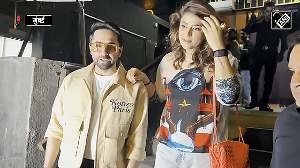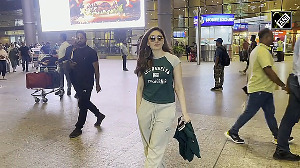Mahant Ramchandra Das Paramhans, who died in the early hours of Thursday, is best known for his crusade for the construction of a Ram temple at the site of the demolished Babri Masjid in Ayodhya. 
Born Chandreshwar Tiwari in a remote village in Bihar's Chhapra district, Paramhans came to Ayodhya in 1934 to join the Naga sadhus. He went on to head the Ayodhya-based Digambar Akhara, one of the most important centres of congregation for Naga sadhus.
He was at the forefront of the Ram temple movement for more than half a century.
He shot into the limelight after reportedly playing an active role in planting an idol of Ram inside the 16th century Babri Masjid on the intervening night of December 22/23, 1949.
The emergence of the idol had then caused a sensation.
It marked the commencement of the practice of Hindus offering prayers at the Babri Masjid, which they believed was built on land marking the birthplace of Lord Ram.
Paramhans was a vociferous proponent of the theory that Mughal emperor Babar's commander Mir Baqi razed an ancient Ram temple to build the Babri Masjid.
A Faizabad court, however, declared the property disputed and ordered that the gates of the shrine be locked.
Shortly after the first application was filed in a Faizabad court in December 1949 to allow Hindus to offer prayers in the mosque, Paramhans in March 1950 filed an application seeking protection for the idol.
Hindus continued to offer prayers from outside the locked gates, while Paramhans persisted with efforts to get the gates opened.
It was only after a good three-and-a-half decades that he succeeded in bringing the issue back in the spotlight when in 1985 he threatened to immolate himself if the gates of the shrine were not unlocked before next year's Ram Navami (the day celebrated as Lord Ram's birthday).
As luck would have it, the then Faizabad district judge upheld his plea. On February 1, 1986, District Judge K M Pandey ordered the gates opened, saying, "Heavens will not fall if the gates are unlocked."
At that juncture, Paramhans was the sole proponent of the temple. But thereafter the Vishwa Hindu Parishad, which till then had almost no roots in Uttar Pradesh, entered the picture, took up the temple demand, and converted it into a mass movement.
Acknowledging his contribution to keeping the issue alive, however, Paramhans was made president of the Ram Janambhoomi Nyas (trust), entrusted with the task of building a Ram temple.
Paramhans remained at the forefront of the temple movement, be it during the firing on karsevaks (volunteers) in 1990 or the actual demolition of the Babri Masjid in 1992 and the subsequent developments till the shiladaan (symbolic donation of pillars) ceremony in March 2002.
In 2002, differences surfaced between him and VHP working president Ashok Singhal when the latter sought to take over the leadership of the temple movement.
Paramhans kept away from the much-hyped 'Purna-ahuti yagya' organised by Singhal in Ayodhya in March 2002 to re-energise the temple movement.
Since then, Paramhans had openly begun to speak in favour of a negotiated settlement.
"I want the Ram temple to be built at the site where Babar had unlawfully erected the Babri Masjid, but my temple will not be built over the blood of a single Muslim," he told disciples.
He was also often heard saying, "If the issue is left to the people of Ayodhya, it can be sorted out. Politicians and politically motivated people, who have only been taking undue mileage out of the issue and are not interested in building the temple, should keep out of it."
This view, perhaps, may have caused the differences Paramhans had with others associated with the temple movement, including Deputy Prime Minister Lal Kishenchand Advani, who helped the Bharatiya Janata Party gain political mileage from the issue.
VHP vice-president Giriraj Kishore went so far as to blame Advani for the heart attack Paramhans suffered on June 12, following which he was shifted to Lucknow for treatment.
"After Paramhans met Advani in Delhi about a month back, he had been quite tense. I am sure Advani was the cause of the tension, which culminated in the heart attack," Kishore had told reporters at that time.
On July 6, Paramhans suffered yet another heart attack while in Ayodhya and was in hospital thereafter, until, on his wishes, he was taken back to Ayodhya to breathe his last.






 © 2025
© 2025